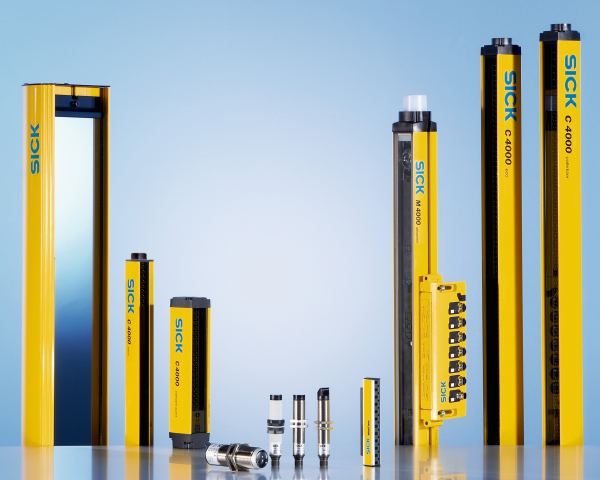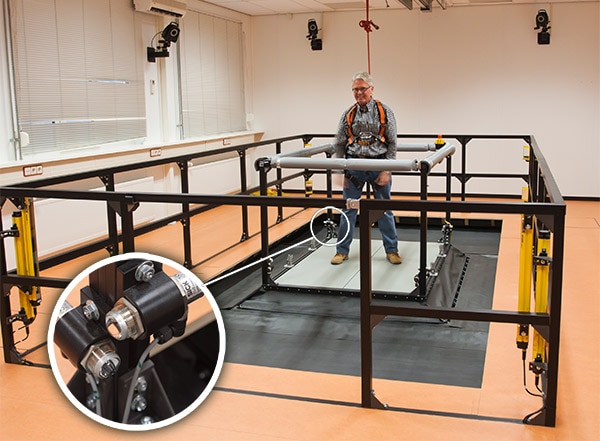Every year more than a million fall accidents are registered per year.The medical product developer BAAT Medical has built a unique fall simulator, which is equipped with safety components from SICK, according to the requirements of the Rehabilitation and Neurology Department of St. Radboud University Hospital in Nijmegen.  Almost ninety thousand older people require emergency medical assistance as a result of falls. For around thirty thousand older people, falls result in inpatient hospital treatment. The related costs for medical care amount to EUR 560 million per year in the Netherlands alone. Roeland Loeffen, engineer and laboratory manager at St. Radboud University Hospital: "These figures clearly show why St. Radboud University Hospital believes there is a need for additional scientific research about the mechanisms at work when older people and neurology patients fall. The newly developed fall simulator allows for considerably more accurate identification of the causes of falls than has ever been possible before. This makes it possible to develop special training programs which can be used to reduce the risk of falling. The simulator is therefore extremely useful in two areas: both in research and in training."
Almost ninety thousand older people require emergency medical assistance as a result of falls. For around thirty thousand older people, falls result in inpatient hospital treatment. The related costs for medical care amount to EUR 560 million per year in the Netherlands alone. Roeland Loeffen, engineer and laboratory manager at St. Radboud University Hospital: "These figures clearly show why St. Radboud University Hospital believes there is a need for additional scientific research about the mechanisms at work when older people and neurology patients fall. The newly developed fall simulator allows for considerably more accurate identification of the causes of falls than has ever been possible before. This makes it possible to develop special training programs which can be used to reduce the risk of falling. The simulator is therefore extremely useful in two areas: both in research and in training."
SICK Sensors Everywhere
 Photoelectric sensors and safety light curtains
Photoelectric sensors and safety light curtains
Arthur Aalsma, Director of Research & Development at BAAT Medical: "The system is equipped with a highly developed user interface. The patient to be examined is fitted with lots of sensors before the examination. In addition, marks are placed all over the area, which can be used to follow and record all movements. During the simulation, the patient stands on a platform." "The large moving platform of the new fall simulator can suddenly be moved in all conceivable directions, and both accelerated and slowed. The more susceptible someone is to falling, the quicker they will lose their balance. However, there can be no serious injuries because the patients wear a safety belt during the sessions. As soon as a patient staggers so severely that their limbs protrude over the platform, this will be detected by the SICK laser sensors and SICK light curtains, and the system will be stopped immediately."
Safety for Employees
Loeffen: "The SICK components also ensure that our employees are safe, as the system will stop immediately if they get too close to the moving platform. Eight L4000 Single-beam photoelectric safety switches are installed around the platform, two positioned on each corner.The barrier is secured with M4000 Standard Multiple light beam safety devices. Fall simulator with L4000 single-beam photoelectric safety switches and M4000 standard multiple light beam safety devices on each side
Fall simulator with L4000 single-beam photoelectric safety switches and M4000 standard multiple light beam safety devices on each side
"An M4000 system without a mirror is installed on the front. The other three sides are each secured with an M4000 with mirrors. As soon as the platform is in the park position on the front side, the front side lock is released via a hardware switch in order to allow users to climb on and off. At that point the barrier can be opened unobstructed."
Positive Partnership with SICK
Aalsma: "In order to reach the first test set-up, you often have to overcome a lot of setbacks. This was also true in the case of this highly developed fall simulator, but we gradually found out which safety components were best suited to the circumstances. SICK was a great help to us during this process. We found the collaboration and their advice to be a very positive experience."
- Product information: L4000 Single-beam photoelectric safety switches, M4000 Standard Multiple light beam safety devices
- Product portfolio: Single-beam photoelectric safety switches, Standard Multiple light beam safety devices
- Customer information: Baat Medical

